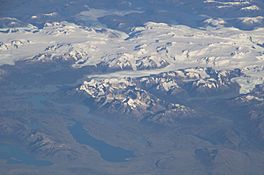Dickson Glacier facts for kids
Quick facts for kids Dickson Glacier |
|
|---|---|

The glacier is visible in the right-center of the image
|
|
| Location | Chile |
| Coordinates | 50°47′S 73°09′W / 50.783°S 73.150°W |
| Area | 71 km2 (27 sq mi) |
| Length | 10 km (6.2 mi) |
The Dickson Glacier is a huge river of ice found in the amazing Torres del Paine National Park in southern Chile. It's like a giant, slow-moving ice stream that flows out from the massive Southern Patagonian Ice Field. Imagine a huge sheet of ice covering mountains and valleys – that's the Southern Patagonian Ice Field, and Dickson Glacier is one of its important parts.
Contents
What is a Glacier?
A glacier is a very large, slow-moving mass of ice. It forms over many, many years as snow piles up, gets compressed, and turns into ice. Glaciers are often called "rivers of ice" because they slowly flow downhill due to gravity. They can carve out valleys and shape landscapes over thousands of years.
How Glaciers Form
Glaciers start when more snow falls in winter than melts in summer. This snow builds up year after year. As new snow falls, it presses down on the old snow, making it denser and denser. Eventually, the snow turns into a special type of ice called glacial ice, which is very thick and dense. Once the ice is thick enough, it starts to move.
Why Glaciers Move
Glaciers move because of gravity. Even though they look solid, the ice slowly deforms and slides. The weight of the ice makes it flow like a very thick liquid. Sometimes, the glacier can also slide on a thin layer of meltwater underneath it, which makes it move a bit faster.
Dickson Glacier's Home: Torres del Paine National Park
Dickson Glacier is located in one of the most beautiful places on Earth: Torres del Paine National Park. This park is famous for its towering granite peaks, bright blue icebergs, and incredible wildlife. It's a popular spot for adventurers and nature lovers from all over the world.
Where is Torres del Paine?
Torres del Paine National Park is in a region called Patagonia, which is at the very southern tip of South America. It's a wild and rugged area shared by Chile and Argentina, known for its strong winds, stunning mountains, and vast ice fields.
The Southern Patagonian Ice Field Connection
Dickson Glacier is directly connected to the Southern Patagonian Ice Field. This ice field is the second-largest continuous ice mass outside of the polar regions. It's a huge reservoir of ice that feeds many glaciers, including Dickson. The ice field is a remnant from the last Ice Age, and it plays a big role in the climate and environment of the region.
Why is Dickson Glacier Important?
Glaciers like Dickson are important for several reasons. They are a significant source of fresh water, as their meltwater feeds rivers and lakes. They also help scientists understand climate change. By studying how glaciers grow or shrink, scientists can learn about changes in temperature and snowfall over time.
Glaciers and Climate Change
Many glaciers around the world, including some in Patagonia, are shrinking due to rising global temperatures. This melting can contribute to rising sea levels and affect local ecosystems. Scientists closely monitor glaciers like Dickson to track these changes and understand their impact on our planet.
See also
 In Spanish: Glaciar Dickson para niños
In Spanish: Glaciar Dickson para niños
- Grey Glacier
- Southern Patagonian Ice Field
- List of glaciers

